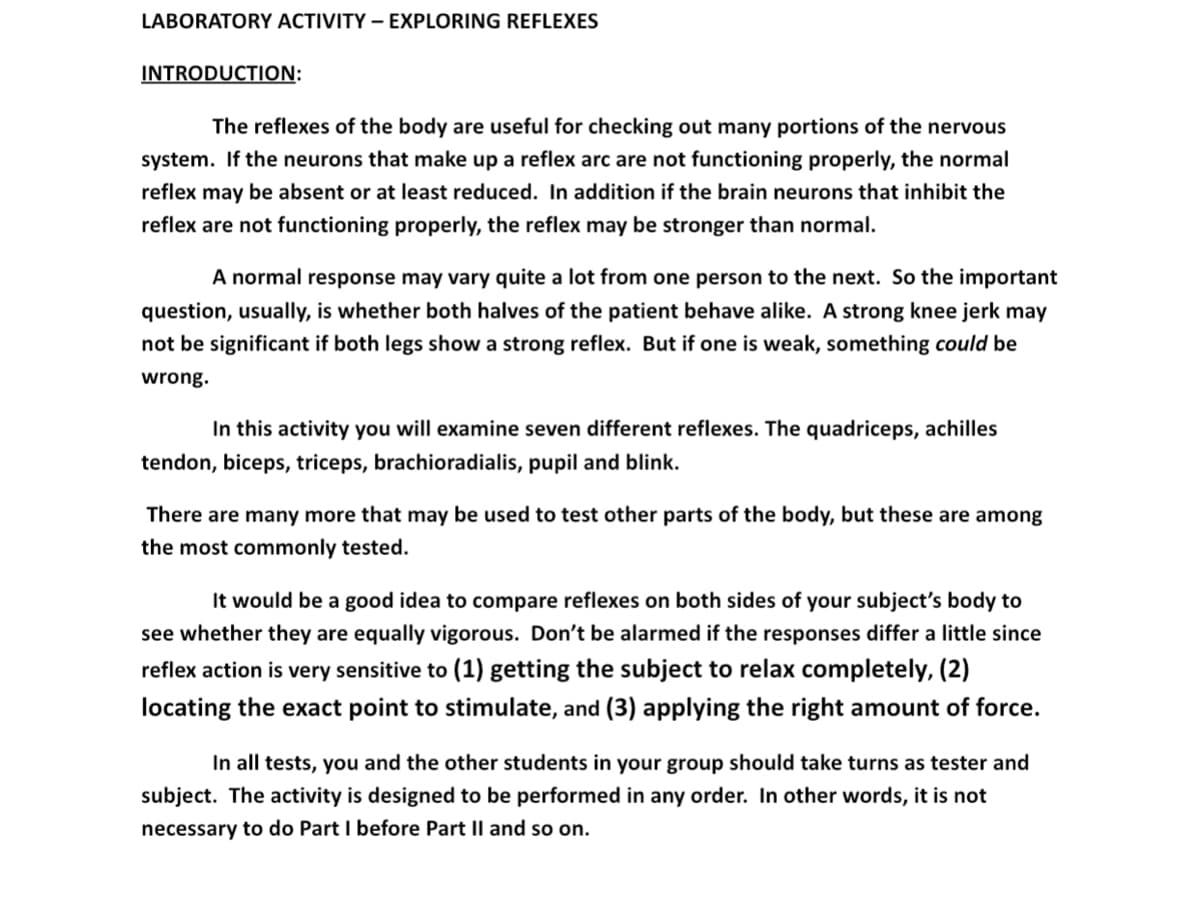Anatomy & Physiology
1st Edition
ISBN:9781938168130
Author:Kelly A. Young, James A. Wise, Peter DeSaix, Dean H. Kruse, Brandon Poe, Eddie Johnson, Jody E. Johnson, Oksana Korol, J. Gordon Betts, Mark Womble
Publisher:Kelly A. Young, James A. Wise, Peter DeSaix, Dean H. Kruse, Brandon Poe, Eddie Johnson, Jody E. Johnson, Oksana Korol, J. Gordon Betts, Mark Womble
Chapter16: The Neurological Exam
Section: Chapter Questions
Problem 7ILQ: Watch this video (http://openstaxcollege.org/l/reflextest) to see how to test reflexes in the...
Related questions
Question
Out of the 7 written, which reflexes are easiest and which were hardest to demonstrate? Why do you think that is?

Transcribed Image Text:LABORATORY ACTIVITY - EXPLORING REFLEXES
INTRODUCTION:
The reflexes of the body are useful for checking out many portions of the nervous
system. If the neurons that make up a reflex arc are not functioning properly, the normal
reflex may be absent or at least reduced. In addition if the brain neurons that inhibit the
reflex are not functioning properly, the reflex may be stronger than normal.
A normal response may vary quite a lot from one person to the next. So the important
question, usually, is whether both halves of the patient behave alike. A strong knee jerk may
not be significant if both legs show a strong reflex. But if one is weak, something could be
wrong.
In this activity you will examine seven different reflexes. The quadriceps, achilles
tendon, biceps, triceps, brachioradialis, pupil and blink.
There are many more that may be used to test other parts of the body, but these are among
the most commonly tested.
It would be a good idea to compare reflexes on both sides of your subject's body to
see whether they are equally vigorous. Don't be alarmed if the responses differ a little since
reflex action is very sensitive to (1) getting the subject to relax completely, (2)
locating the exact point to stimulate, and (3) applying the right amount of force.
In all tests, you and the other students in your group should take turns as tester and
subject. The activity is designed to be performed in any order. In other words, it is not
necessary to do Part I before Part II and so on.
Expert Solution
This question has been solved!
Explore an expertly crafted, step-by-step solution for a thorough understanding of key concepts.
This is a popular solution!
Trending now
This is a popular solution!
Step by step
Solved in 2 steps

Knowledge Booster
Learn more about
Need a deep-dive on the concept behind this application? Look no further. Learn more about this topic, biology and related others by exploring similar questions and additional content below.Recommended textbooks for you

Anatomy & Physiology
Biology
ISBN:
9781938168130
Author:
Kelly A. Young, James A. Wise, Peter DeSaix, Dean H. Kruse, Brandon Poe, Eddie Johnson, Jody E. Johnson, Oksana Korol, J. Gordon Betts, Mark Womble
Publisher:
OpenStax College

Biology: The Dynamic Science (MindTap Course List)
Biology
ISBN:
9781305389892
Author:
Peter J. Russell, Paul E. Hertz, Beverly McMillan
Publisher:
Cengage Learning

Anatomy & Physiology
Biology
ISBN:
9781938168130
Author:
Kelly A. Young, James A. Wise, Peter DeSaix, Dean H. Kruse, Brandon Poe, Eddie Johnson, Jody E. Johnson, Oksana Korol, J. Gordon Betts, Mark Womble
Publisher:
OpenStax College

Biology: The Dynamic Science (MindTap Course List)
Biology
ISBN:
9781305389892
Author:
Peter J. Russell, Paul E. Hertz, Beverly McMillan
Publisher:
Cengage Learning